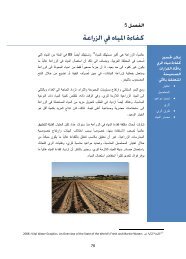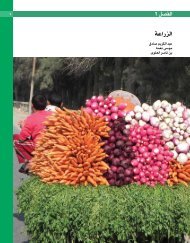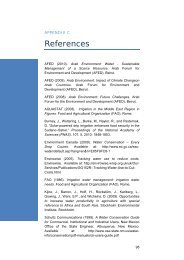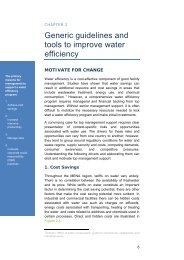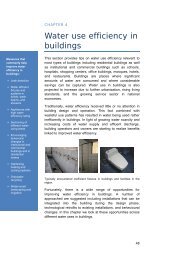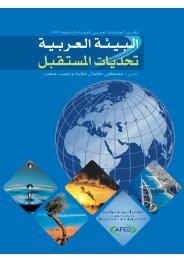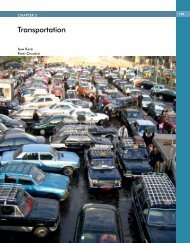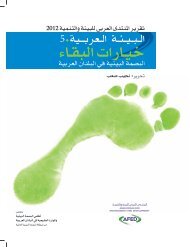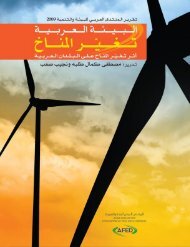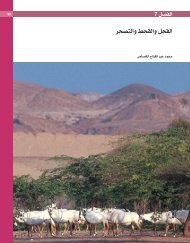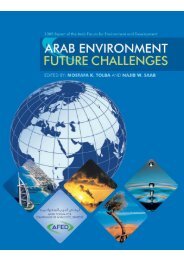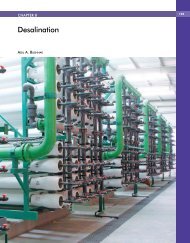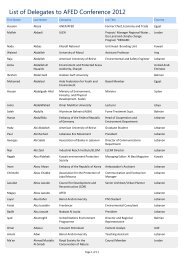Impact of Climate Change on Arab Countries - (IPCC) - Working ...
Impact of Climate Change on Arab Countries - (IPCC) - Working ...
Impact of Climate Change on Arab Countries - (IPCC) - Working ...
You also want an ePaper? Increase the reach of your titles
YUMPU automatically turns print PDFs into web optimized ePapers that Google loves.
ARAB ENVIRONMENT: CLIMATE CHANGE 65<br />
The FAO (2005) expects growth rates in world<br />
agricultural producti<strong>on</strong> to decline from 2.2%/yr<br />
during the past 30 years to 1.6%/yr during the<br />
2000 to 2015 period, 1.3%/yr between 2015<br />
and 2030 and 0.8%/yr between 2030 and 2050.<br />
This still implies a 55% increase in global crop<br />
producti<strong>on</strong> by 2030 and an 80% increase to<br />
2050 (compared with 1999 to 2001). Globally,<br />
to facilitate this growth in output, 185 milli<strong>on</strong><br />
ha <str<strong>on</strong>g>of</str<strong>on</strong>g> rain-fed crop land (+19%) and 60 milli<strong>on</strong><br />
ha <str<strong>on</strong>g>of</str<strong>on</strong>g> irrigated land (+30%) will have to be<br />
brought into producti<strong>on</strong>. Expanded land use<br />
and improved technology are the essential reas<strong>on</strong>s<br />
c<strong>on</strong>tributing to yields’ expected rise. Cereal<br />
yields in developing countries are projected to<br />
increase from 2.7 t<strong>on</strong>nes/ha currently to 3.8<br />
t<strong>on</strong>nes/ha in 2050 (FAO, 2005). These<br />
improvements in the global supply-demand balance<br />
will be accompanied by a decline in the<br />
number <str<strong>on</strong>g>of</str<strong>on</strong>g> undernourished people from more<br />
than 800 milli<strong>on</strong> at present to about 300 milli<strong>on</strong>,<br />
or 4% <str<strong>on</strong>g>of</str<strong>on</strong>g> the populati<strong>on</strong> in developing<br />
countries, by 2050 (FAO, 2005).<br />
Notwithstanding these overall improvements,<br />
important food-security problems remain to be<br />
addressed at the local and nati<strong>on</strong>al levels. Areas<br />
with high rates <str<strong>on</strong>g>of</str<strong>on</strong>g> populati<strong>on</strong> growth and natural<br />
resource degradati<strong>on</strong> are likely to c<strong>on</strong>tinue to<br />
have high rates <str<strong>on</strong>g>of</str<strong>on</strong>g> poverty and food insecurity<br />
(Alexandratos, 2005). Cassman et al. (2003)<br />
emphasize that climate change will add to the<br />
dual challenge <str<strong>on</strong>g>of</str<strong>on</strong>g> meeting food demand while at<br />
the same time efforts are in progress for protecting<br />
natural resources and improving envir<strong>on</strong>mental<br />
quality in these regi<strong>on</strong>s.<br />
many agricultural and forestry impacts. Most<br />
<strong>Arab</strong> countries are characterized by limited<br />
water resources and high water demands. The<br />
total annual renewable water resources in the<br />
<strong>Arab</strong> world are about 460 km3, or about 0.9%<br />
<str<strong>on</strong>g>of</str<strong>on</strong>g> the global annual renewable water resources.<br />
Based <strong>on</strong> annual water resources per capita, all<br />
<strong>Arab</strong> countries are facing a vulnerable water situati<strong>on</strong>,<br />
except Iraq which has renewable water<br />
resources <str<strong>on</strong>g>of</str<strong>on</strong>g> more than 2900 m3/capita/year.<br />
Leban<strong>on</strong> and Syria are currently facing water<br />
stress (1,000 to 1,700 m3/capita/year), while<br />
the rest <str<strong>on</strong>g>of</str<strong>on</strong>g> the <strong>Arab</strong> countries are facing water<br />
scarcity (less than 1,000 m3/capita/year)<br />
(AFED, 2008). The agriculture sector uses over<br />
80% <str<strong>on</strong>g>of</str<strong>on</strong>g> the total water resources <str<strong>on</strong>g>of</str<strong>on</strong>g> the <strong>Arab</strong><br />
world. However, the water use efficiency <str<strong>on</strong>g>of</str<strong>on</strong>g> the<br />
agriculture sector in most <str<strong>on</strong>g>of</str<strong>on</strong>g> the <strong>Arab</strong> countries<br />
is low (M<strong>on</strong>tazar et al., 2007).<br />
The producti<strong>on</strong> and disseminati<strong>on</strong> <str<strong>on</strong>g>of</str<strong>on</strong>g> seas<strong>on</strong>al<br />
climate forecasts has improved the ability <str<strong>on</strong>g>of</str<strong>on</strong>g><br />
many resource managers to anticipate and plan<br />
for climate variability (Harris<strong>on</strong>, 2005).<br />
However, problems related to infectious disease,<br />
c<strong>on</strong>flicts and other societal factors may decrease<br />
the capacity to resp<strong>on</strong>d to climate variability and<br />
change at the local level, thereby increasing current<br />
vulnerability. Policies and resp<strong>on</strong>ses made at<br />
nati<strong>on</strong>al and internati<strong>on</strong>al levels also influence<br />
local adaptati<strong>on</strong>s (Salinger et al., 2005). Nati<strong>on</strong>al<br />
agricultural policies are <str<strong>on</strong>g>of</str<strong>on</strong>g>ten developed <strong>on</strong> the<br />
basis <str<strong>on</strong>g>of</str<strong>on</strong>g> local risks, needs and capacities, as well as<br />
internati<strong>on</strong>al markets, tariffs, subsidies and trade<br />
agreements (Burt<strong>on</strong> and Lim, 2005).<br />
Water balance and weather extremes are key to



